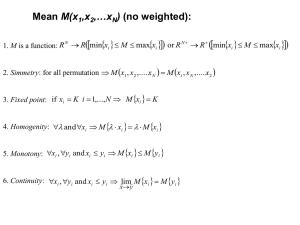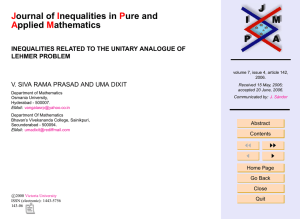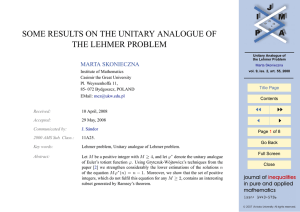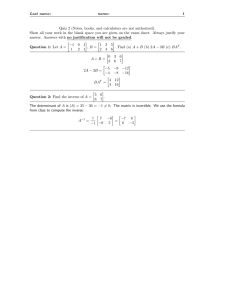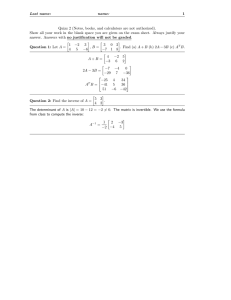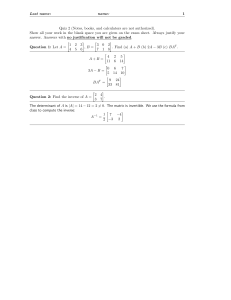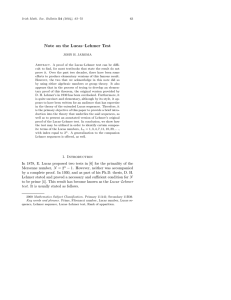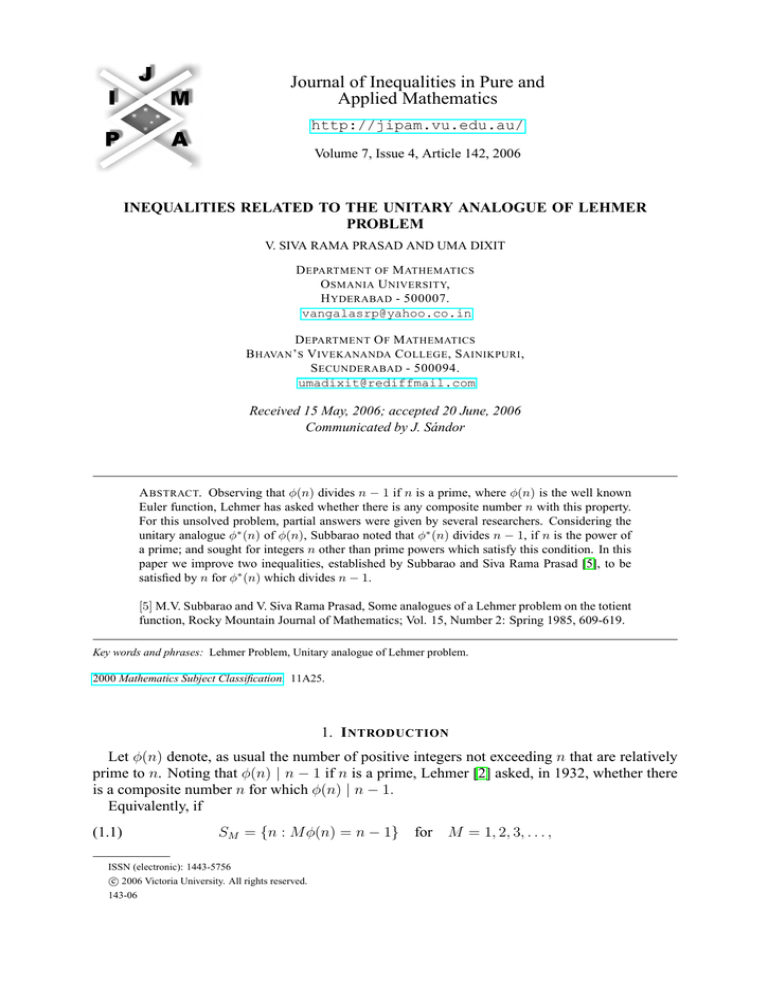
Journal of Inequalities in Pure and
Applied Mathematics
http://jipam.vu.edu.au/
Volume 7, Issue 4, Article 142, 2006
INEQUALITIES RELATED TO THE UNITARY ANALOGUE OF LEHMER
PROBLEM
V. SIVA RAMA PRASAD AND UMA DIXIT
D EPARTMENT OF M ATHEMATICS
O SMANIA U NIVERSITY,
H YDERABAD - 500007.
vangalasrp@yahoo.co.in
D EPARTMENT O F M ATHEMATICS
B HAVAN ’ S V IVEKANANDA C OLLEGE , S AINIKPURI ,
S ECUNDERABAD - 500094.
umadixit@rediffmail.com
Received 15 May, 2006; accepted 20 June, 2006
Communicated by J. Sándor
A BSTRACT. Observing that φ(n) divides n − 1 if n is a prime, where φ(n) is the well known
Euler function, Lehmer has asked whether there is any composite number n with this property.
For this unsolved problem, partial answers were given by several researchers. Considering the
unitary analogue φ∗ (n) of φ(n), Subbarao noted that φ∗ (n) divides n − 1, if n is the power of
a prime; and sought for integers n other than prime powers which satisfy this condition. In this
paper we improve two inequalities, established by Subbarao and Siva Rama Prasad [5], to be
satisfied by n for φ∗ (n) which divides n − 1.
[5] M.V. Subbarao and V. Siva Rama Prasad, Some analogues of a Lehmer problem on the totient
function, Rocky Mountain Journal of Mathematics; Vol. 15, Number 2: Spring 1985, 609-619.
Key words and phrases: Lehmer Problem, Unitary analogue of Lehmer problem.
2000 Mathematics Subject Classification. 11A25.
1. I NTRODUCTION
Let φ(n) denote, as usual the number of positive integers not exceeding n that are relatively
prime to n. Noting that φ(n) | n − 1 if n is a prime, Lehmer [2] asked, in 1932, whether there
is a composite number n for which φ(n) | n − 1.
Equivalently, if
(1.1)
SM = {n : M φ(n) = n − 1}
ISSN (electronic): 1443-5756
c 2006 Victoria University. All rights reserved.
143-06
for
M = 1, 2, 3, . . . ,
2
V. S IVA R AMA P RASAD AND U MA D IXIT
S
then the Lehmer problem seeks composite numbers in S = M >1 SM . For this problem, which
has not been settled so far, several partial answers were provided, the details of which can be
found in [5]. Lehmer [2] has shown that
(1.2)
If n ∈ S, then n is square free.
It is well known that a divisor d > 0 of a positive integer n for which (d, n/d) = 1 is called
a unitary divisor of n. For positive integers a and b, the greatest divisor of a which is a unitary
divisor of b is denoted by (a, b)∗ .
E. Cohen [1] has defined φ∗ (n), the unitary analogue of the Euler totient function, as the
number of integers a with 1 ≤ a ≤ n and (a, n)∗ = 1. It can be seen that φ∗ (1) = 1 and if
n > 1 with n = pα1 1 pα2 2 pα3 3 · · · · · · pαr r , then
(1.3)
φ∗ (n) = (pα1 1 − 1)(pα2 2 − 1) · · · (pαr r − 1)
Noting that φ∗ (n) | n − 1 whenever n is a prime power, Subbarao [3] has asked whether nonprime powers n exist with this property and this is the unitary analogue of the Lehmer problem.
If
(1.4)
∗
SM
= {n : M φ∗ (n) = n − 1} for
M = 1, 2, 3, . . . ,
[
∗
∗
the problem seeks non-prime powers in SM
=
SM
.
M >1
For excellent information on the Lehmer problem, its generalizations and extensions, we
refer readers to the book of J. Sandor and B. Crstici ([3, p. 212-215]).
Let Q denote the set of all square free numbers. Since φ∗ (n) = φ(n) for n ∈ Q, it follows
∗
that SM
∩ Q = SM for each M > 1 and therefore S ∗ ∩ Q = S, showing S ⊂ S ∗ and hence a
separate study of S ∗ is meaningful.
In a study of certain analogues of the Lehmer problem, Subbarao and Siva Rama Prasad [5]
have proved, among other things, that if ω(n) = r is the number of distinct prime factors of
n ∈ S ∗ then
ω(n) ≥ 11
(1.5)
and that
n < (r − 1)2
(1.6)
r −1
The purpose of this paper is to prove Theorems A and B (see Section 3) which improve (1.5)
and (1.6) respectively.
2. P RELIMINARIES
We state below the results proved in [4] which are needed for our purpose.
(2.1)
If n ∈ S ∗ , then n is odd and is not a powerful number.
A number is said to be powerful if each prime dividing it is of multiplicity at least 2.
(2.2)
If n ∈ S ∗ and p, q are primes such that p divides n and q β ≡ 1(mod p),
then q β cannot be a unitary divisor of n.
(2.3)
If n ∈ S ∗ and 3|n then ω(n) ≥ 1850.
(2.4)
If n ∈ S ∗ , 3 - n and 5 | n then ω(n) ≥ 11.
J. Inequal. Pure and Appl. Math., 7(4) Art. 142, 2006
http://jipam.vu.edu.au/
U NITARY A NALOGUE OF L EHMER P ROBLEM
3
(2.5)
If n ∈ S ∗ , 3 - n and 5 - n then ω(n) ≥ 17.
(2.6)
If n ∈ S ∗ , with 2 < ω(n) ≤ 16 then n ∈ S2∗ , 3 - n, 5 | n and 7 | n.
∗
Suppose n ∈ SM
for some M > 1. Then
2<
(2.7)
n
φ∗ (n)
> M ≥ 2, which gives
n
for all n ∈ S ∗ .
φ∗ (n)
Also if n ∈ S ∗ is of the form
(2.8)
n = pα1 1 pα2 2 pα3 3 · · · pαr r with p1 < p2 < · · · < pr ,
then by (2.1) at least one αi = 1
∗
and n = pα1 1 pα2 2 pα3 3 · · · · · · pαr r , with
(2.9) ([5, Lemma 5.3]): If n ∈ SM
pα1 1 < pα2 2 < · · · < pαr r , then pαi i < (r − i + 1)
i−1
Y
α
pj j for i = 2, 3, . . . , r.
j=1
(2.10) ([5, Lemma 5.3]): If n = pα1 1 pα2 2 pα3 3 · · · pαr r , with
r
n
pα1 1 < pα2 2 < · · · < pαr r is such that ∗
> 2, then pα1 1 < 2 + 2
.
φ (n)
3
3. M AIN R ESULTS
Theorem A. If n ∈ S ∗ and 455 is not a unitary divisor of n then ω(n) ≥ 17.
Proof. (2.3) and (2.5) respectively prove the theorem in the cases 3|n and 15 - n.
Therefore we assume that 3 - n and 5 | n.
Let n be of the form (2.8) with ω(n) ≤ 16 then by (2.6), n ∈ S2∗ , 5|n and 7|n. That is
p1 = 5, p2 = 7 and so n = 5α1 7α2 pα3 3 · · · pαr r , where pi 6≡ 1(mod 5) and pi 6≡ 1(mod 7) for
i ≥ 3, in view of (2.2).
Suppose A is a set of primes (in increasing order) containing 5 and 7; and those primes p
with p 6≡ 1(mod 5) and p 6≡ 1(mod 7). Denote the ith element of A by ai so that a1 = 5, a2 =
7, a3 = 13, a4 = 17, a5 = 19, a6 = 23, a7 = 37, . . . .
Now since
r
Y
n
pαi i
=
φ∗ (n) i=1 pαi i − 1
increases with r and r ≤ 16, we consider the case r = 16 and prove that the product on the
right is < 2 in this case, which contradicts (2.7).
Therefore r ≤ 16 cannot hold, proving the theorem.
If r = 16 and p3 6= a3 , then pi ≥ ai+1 for i ≥ 3 so that, in view of the fact that x/(x − 1) is
decreasing, we get
16
16
n
5α1
7α2 Y pαi i
5 7 Y ai+1
=
.
.
<
.
<2
φ∗ (n)
5α1 − 1 7α2 − 1 i=3 pαi i − 1
4 6 i=3 ai+1 − 1
Hence p3 = a3 . Now since 132 ≡ 1(mod 7) we get, by (2.2), 2 - α3 and so n = 5α1 7α2 13α3 · · · pα1616 ,
where α3 is odd. Further since 455 is not a unitary divisor of n, we must have α1 α2 α3 > 1.
J. Inequal. Pure and Appl. Math., 7(4) Art. 142, 2006
http://jipam.vu.edu.au/
4
V. S IVA R AMA P RASAD AND U MA D IXIT
If α1 α2 = 1 or α1 α2 > 1, we get contradiction to (2.7). In fact in case α1 α2 = 1, we must
have α3 ≥ 3 so that
pα3 3
2197
133
=
≤ 3
α3
2196
p3 − 1
13 − 1
and therefore
16
n
5 7 2197 Y ai
< · ·
<2
φ∗ (n)
4 6 2196 i=4 ai − 1
and in case α1 α2 > 1, it is enough to consider the case α3 = 1, so that in this case
16
n
5 7 13 Y ai
<
· ·
<2
φ∗ (n)
4 6 12 i=4 ai − 1
Finally the case α1 > 1, α2 > 1, and α3 > 1 can be handled similarly.
Theorem B. If n ∈ S ∗ with ω(n) = r and 455 does not divide n unitarily then n < r −
Proof. Let n =
we have
pα1 1 pα2 2 pα3 3
· · · pαr r , where
pα1 1
(3.1)
<2+2
pα1 1
r
<
pα2 2
<r−
3
Now by (2.9) and (3.1), we successively have
18
23
α1
p1 < r −
< r−
5
10
1) pα1 1
10
< · · · < pαr r . By (2.10) and Theorem A,
18
,
5
for r ≥ 17.
2
23
18
< r−
< (r −
< (r − 1) r −
5
10
22
23
pα3 3 < (r − 2) pα1 1 pα2 2 < r −
10
···
2r−1
23
αr
pr < r −
.
10
2r −1
Multiplying all these inequalities we get, n < r − 23
, proving the theorem.
10
pα2 2
23 2r −1
R EFERENCES
[1] E. COHEN, Arithmetical functions associated with the unitary divisors of an integer, Math. Zeitschr,
74 (1960), 66–80.
[2] D.H. LEHMER, On Euler’s totient function, Bull. Amer. Math. Soc., 38 (1932), 745–751.
[3] J. SÁNDOR AND B. CRSTICI, Handbook of Number Theory II, Kluwer Academic Publishers, Dordrecht/Boston/London, 2004.
[4] M.V. SUBBARAO, On a problem concerning the Unitary totient function φ∗ (n), Not. Amer. Math.
Soc., 18 (1971), 940.
[5] M.V. SUBBARAO AND V. SIVA RAMA PRASAD, Some analogues of a Lehmer problem on the
totient function, Rocky Mountain J. of Math., 15(2) (1985), 609–619.
J. Inequal. Pure and Appl. Math., 7(4) Art. 142, 2006
http://jipam.vu.edu.au/
.

